
All images © by Roberto Piperno, owner of the domain. Write to romapip@quipo.it.
Notes:
Page added in November 2025.

All images © by Roberto Piperno, owner of the domain. Write to romapip@quipo.it.
Notes:
Page added in November 2025.
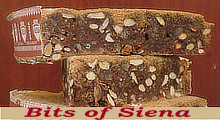 Bits of Siena - Cathedral: Interior
Bits of Siena - Cathedral: InteriorYou may wish to take a look at a page covering the exterior of the Cathedral first.
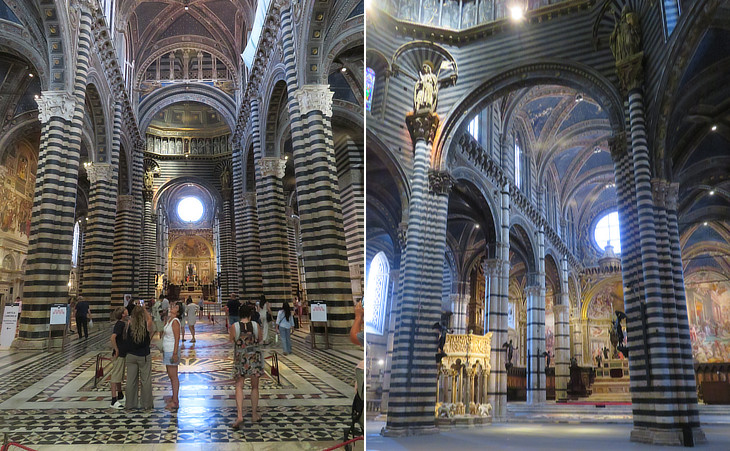
(left) Main nave; (right) choir
The interior exhibits but a small portion of the building as it was originally begun and left unfinished still show the gigantic scale of the first design. The pillars are clustered, and the capitals are ornamented with foliage and figures. The lower arches are semicircular, but those of the clerestory and its windows are pointed. The choir is lighter, and in both ends is a rich wheel window. It was intended to have formed only one of the side aisles of the projected edifice, which was abandoned on account of the plague in 1348.
John Murray - Handbook for travellers in Central Italy - 1843
The plan, which on paper seems fairly simple, is extremely intricate and difficult to understand in the building, being complicated by the irregularity of the transept and its adjuncts, the unusual form of the hexagonal dome, and the intrusion of the campanile into
the body of the building. The wide spacing of the columns and great span of the arches, the absence of buttresses and triforium, and the flatness of the roofs all belong to the Southern School, as well as the small
windows, which would have been wholly insufficient in
the North. Inside and out the walls are faced with
white marble banded with black. Above the columns is a pedestal or stilt,
from which the arches spring. In the choir
the arches have a suspicion of a point, and the extrados
seems slightly to widen as it rises, but of this I cannot
feel quite sure. In the nave the arches seem semi-circular. The vaults are quadripartite, the transverse
rib of a plain flat section is round-arched, the wall rib is
pointed and very slight, with dentils; the diagonal is
a pointed roll in section. All the windows are pointed
and have tracery.
Thomas Graham Jackson - Gothic architecture in France, England, and Italy - 1915

Arches of the main nave with terracotta busts of the Popes
All the roofe of the Church is
painted of skie colour, and all set with starres. Upon
the inside, and in the upper part of the Church, are the
Images of the Popes, wrought in stone to the shoulders,
set round about, where betweene Gregorie the fourth,
and Adrian the second, I wondred to see the head of
Pope Joane, with the inscription naming her, especially
in a Citte so neere Rome.
Fynes Moryson - An Itinerary: Containing His Ten Years Travel Through .. Italy (in 1594)
About the body of the church, on a cornice within, are inserted the heads of all the Popes. Evelyn
The arched roof of the church is azured, and strewed with stars of gold and with a series of the popes.
Thomas Nugent - The Grand Tour - 1749
The pillars of the aisles are crossed by alternate layers of black and white marble, which I once condemned, conceiving that even a pillar, if round, should appear one piece: - "but Sir," said a Senese "black and white are the colours of our city banner." Round the vault of the nave is a set of staring heads cast in terra cotta, each bearing the name of a different Pope, although several came evidently from the same mould. Whoever is determined to complete a series will forge what he cannot find. I have seen things as rude and unauthentic as these installed as originals by our portrait engravers.
Joseph Forsyth - Remarks on Antiquities, Arts, and Letters in Italy in 1802-1803
Over the lower arches of the nave the frieze is ornamented with a series of terra-cotta heads of all the popes down to Alexander III. in altorelievo, among which that of Pope Zacharias was originally the bust of Pope Joan, and had the inscription, Johannes VIII., Femina de Anglia. It was metamorphosed in 1600 by the grand-duke, at the suggestion, it is said, of Clement VIII. and Cardinal Tarugi. Many of the antipopes are in the series, but, like all collections professing to be complete, several are either inventions or duplicates. Murray
The columns, which
are also of black and white marble, are clustered, and
have capitals with two tiers of leaves, and the
hollow Corinthian abacus surmounted by a shallow square
with little dentils. Graham Jackson
* * *
Similar to other important Italian churches the Cathedral of Siena was embellished with works of art of different styles which testify to its long history. Some of these works of art are illustrated in this page following a broad chronological order.

(left) Dome; (right) pulpit
The dome is an irregular hexagon, all
the sides being unequal, and it is gradually brought by
tromps to a circle for the lantern. Graham Jackson
The pulpit is beautified with marble figures, a piece of exquisite work.
John Evelyn - Diary and Correspondence related to his stay in Italy in 1644
The pulpit is universally admired : it is exquisitely carved, but in too many patterns of decoration; it wants the unity of design necessary to so small an object. Being built, as usual, of marble it becomes a part of the cathedral itself, and hurtful to the general symmetry. Forsyth
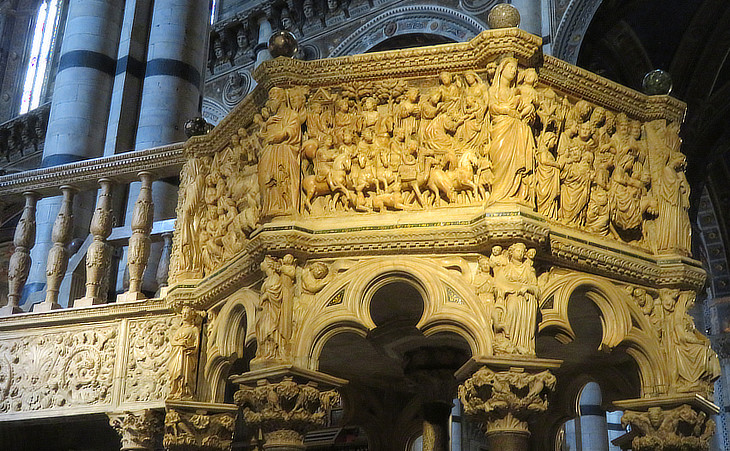
Pulpit: Nativity with the Three Magi
The octagonal pulpit of white marble, supported by a circle of columns, one in the centre and eight around it, four of which rest on lions playing with their cubs, is a remarkable work of Niccol˛ di Pisa, with the date 1226; the Last Judgment, represented in one of its bas-reliefs, is perhaps one of the finest productions of this illustrious artist. The pulpit at Pisa was not executed till thirty years later, but that of Siena, is not inferior as a work of art, and is justly regarded as one of the finest productions of this great master. Murray
The pulpit was actually made in 1266 after that of Pisa (it opens in another window).
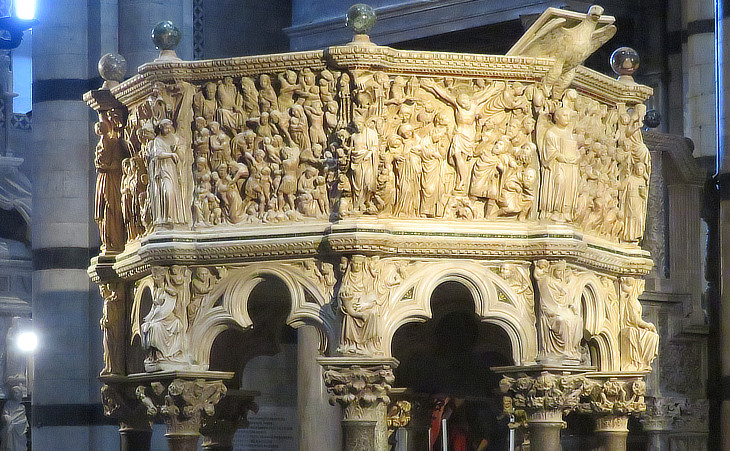
Pulpit: (left) Massacre of the Innocents; (right) Crucifixion
It was in the year 1266, that Niccola Pisano came from Bologna to Siena to make a contract for a pulpit for the Duomo, by which he bound himself to reside in that city until its completion, with liberty to visit Pisa four times a year, (..) and consented to be paid at the rate of eight soldi a day besides his living. His assistants were to be his son Giovanni, and his scholars Arnolfo del Cambio, Donato, and Lapo.
As the pulpit was to stand beneath the dome of an immense cathedral, Niccola made it of larger dimensions than that at Pisa, and octagonal instead of hexagonal. He also almost exactly repeated the bas-reliefs of the Nativity and the Crucifixion of his Pisan pulpit in two of its panels, but treated those of the Adoration and the Last Judgment quite differently, and added two entirely new compositions representing the Massacre of the Innocents and the Flight into Egypt.
As in the Pisan, the columns of the Sienese pulpit rest upon the backs of lions, and have statuettes placed singly and in groups above their capitals; while its flat spaces are filled in with open work, leaves, grotesques, and gilded glass mosaics.
Charles C. Perkins - Tuscan Sculptors - 1864

Pulpit: Renaissance staircase leading to the pulpit
It is entered by an elaborately ornamented staircase in the style of the Renaissance, which, though exquisite in workmanship, is not in harmony with the main structure. On this account, and also because the eye is distracted by the grandeur and beauty of the great cathedral in which it stands, the Sienese pulpit is less effective than the Pisan, which, being the one object of attraction in the Baptistry, completely absorbs the attention.
The residence of Niccola Pisano at Siena was most important in its influence upon the Siennese school of sculpture, which, though then inferior, rose to considerable eminence in the next century. The sixty-one sculptors who kept open shop in the city at the period of Niccola's visit, were in fact mere stone-cutters, who with their brother architects had been formed into a corporation since the year 1212, from which period until the middle of the following century their numbers increased; and after Niccola Pisano had endowed their city with an admirable subject for study in his famous pulpit, they made great progress and paved the way for Agostino and Angelo, Gano, Goro, and Tino in the fourteenth century, and for Quercia in the fifteenth. Perkins
In 1532 the pulpit was relocated to the left side of the choir and in 1543 a staircase was designed to give access to it. On that occasion the height of the pulpit was raised by placing marble pedestals under its columns and lions.

Monument to Cardinal Riccardo Petroni by Tino di Camaino (after 1314 - left transept)
The monument was attributed also to Gano Senese, another of the sculptors mentioned by Perkins. It follows a pattern developed by Arnolfo di Cambio in the Monument to Cardinal Guillaume de Braye (1285) at Orvieto and by Lorenzo Maitani, a sculptor and architect from Siena, in the Monument to Pope Benedict XI (after 1304) at Perugia. A similar monument was made by Angelo and Agostino, two other sculptors from Siena, for Bishop Guido Tarlati at Arezzo.
Cardinal Riccardo Petroni was born in Siena in ca 1350 and was created cardinal deacon of S. Eustachio in 1298 by Pope Boniface VIII. He defended the memory of that Pope against the calumnious accusations of King Philippe IV le Bel of France. Legate of Pope Clement V in Genoa, he died there in 1314. Four years later, his remains were taken to Siena and buried in the cathedral.

Floor: (left) Prudence by Martino di Bartolomeo (1406), one of the oldest floor mosaics which was based only on black and white marbles; (right) Death of Absalom whose head was caught in the boughs of an oak tree when he was fleeing from his father's army by Piero del Minella (1447) where red marble was employed to depict the ground
All the pavement
is most beautifull of ingraven Marble, adorned with
Images of the five Sybills; and there be in this Church
some twentie Images of mixt mettall, besides many other
of Marble. Moryson
What exceeds all description is the pavement, where (besides the various emblems and other figures in the nave) the choir is wrought with the history of the Bible, so artificially expressed in the natural colours of the marbles, that few pictures exceed it. Evelyn
About halfe the Church on the ground is worked in
Marble the story of Moses and Abraham and many of the
Patriarchs, and is esteemed so admirable a piece, as well
for antiquity as excellency of worke, that the like is
hardly to be found again in Christendome, for which cause
they keepe the place covered made with boards for the
purpose.
Francis Mortoft - Journal of his travels in France and Italy in 1659
September 1790. The particular curiosity, of which this church may justly boast, is its elegant mosaic pavement. The following minute account of it, extracted from the Diario Senese by Gigli, and the Lettere Senesi by Della Valle, may prove interesting to my readers. Duccio of Siena, in 1350, began that part of it, which is beneath the altar of St. Ansano. In 1424, the pavement under the three steps of the high altar, representing David, Sampson, Moses, Judas Maccabeus, and Joshua, was completed; and forty years afterwards Matteo da Siena proceeded to embellish the part under the altar, of the crucifix, with the history of the martyrdom of the Innocents. The twelve sybills were added in 1483; and in 1500, Domenico Beccafumi, alias Mecarino, completed this magnificent pavement, by executing the middle part, next the pulpit. (..)
The style differs entirely from that adopted by the Greeks and Romans, who invariably used small square tessera, of various colours; whereas these at Siena are large pieces of marble artfully inlaid, and resemble, in effect, drawings in black and white chalk. This exquisite work is held in proper estimation by the curatores of the church, is kept covered with planks, and displayed only on particular occasions. A beautiful and perfect portion is to be seen under the bishop's pulpit.
Richard Colt Hoare - A classical tour through Italy and Sicily - publ. in 1819
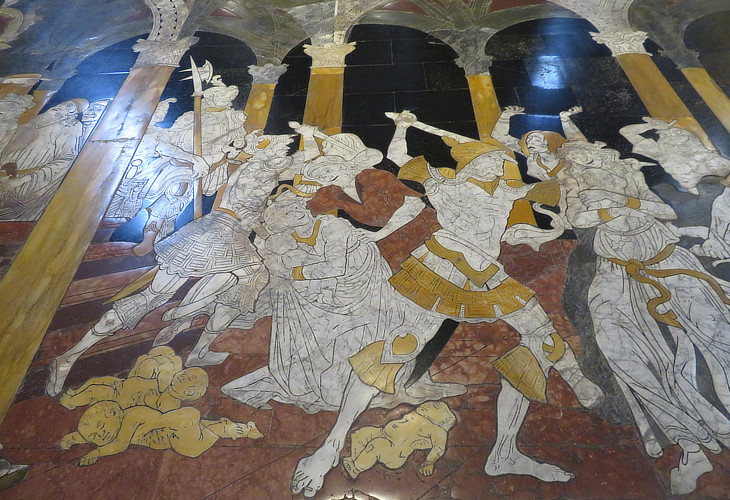
Floor: Massacre of the Innocents by Matteo di Giovanni (1482) where also yellow marble was employed to add vividness to the scene
The Pavement is the best in the world, and indeed too good to be trod on hence they cover a great part of it with boards hansomely laid together, yet easy to be taken up, to shew Strangers the beauty of it. Its of marble inlaid into pictures, and those very great ones: several great marbles of several colours making the Shadows and the lights and composing all together such a new kind of Mosaick work, as all men admire, but none dare finish. This work was begun by Duccio Sanese and afterwards carryed on by Dominico Beccafumi, but not finished by him; saith Vasari. They told me here, that it was Meccharini (*) that made this pavement, but I had
rather believe Vasari. That part which they uncovered for us, represented the History of Abraham going to Sacrifice his Son Isaac; and the History of the Macchabees, and the like. I confess, I scarce saw any thing in Italy which pleased me better then this Pavement.
Richard Lassels - The Voyage of Italy, or a Compleat Journey through Italy in ca 1668
Part of this Church is paved with Marble inlaid , or a more elegant sort of Mosaic work, containing part of the History of the Bible. This pavement is covered with a moveable floor of boards to preserve it.
John Ray - Observations topographical, moral, and physiological: published in 1673.
(*) Meccarino was a nickname for Domenico Beccafumi and not another artist.
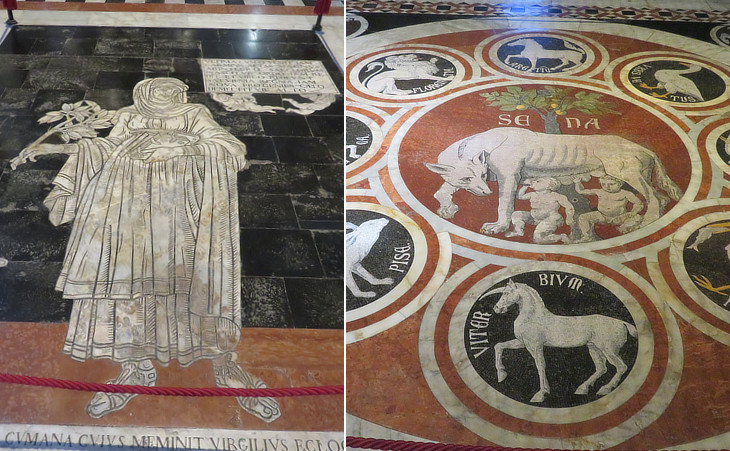
Floor: (left) Sibyl of Cuma who according to Virgil foretold the coming of a saviour; Christians later identified this saviour as Jesus; by Urbano da Cortona (1482); (right) symbols of Siena and allied towns (1373 - remade); the image used as background for this page shows a detail of a mosaic depicting the Wheel of Fortune
The cathedral is a fine Gothic structure, faced with marble without and within; the pavement is of white and black marble, the pieces of which are figured and joined together in the choir, after the manner of Mosaic. This work was begun by Duccio, and finished by Dominic Beccafumi; the part next the choir represents Abraham's sacrifice, with the passage through the Red-Sea. In this church they have like-wise the images of all the Sibyls, with their characters, and prophecies. Nugent
The pavement of this cathedral is the work of a succession of artists from Duccio down to Meccarino, who have produced the effect of the richest mosaic, merely by inserting grey marble into white and hatching both with black mastic. The grandest composition is the history of Abraham, a figure which is unfortunately multiplied in the same compartments; but, when grasping the knife, the patriarch is truly sublime. These works lay exposed at least for 100 years to the general tread, and have been rather improved than defaced by the attrition; for one female figure which had never been trodden looks harsher than the rest. Those of the choir were opportunely covered two centuries ago.
This work has occasioned more discussion than it deserves. It is certainly interesting as a monument of early art; but were the design more admirable than it really is, the very simplicity of execution unfits it for a pavement, and requires distance to soften and set off the forms. The work is not mosaic, for there is no tessellation. It is not strictly the "pavimentum sectile" for that consisted in regular-lined figures. Here it passes for the invention of Duccio, and is original on this floor. Here, as on the ancient vases, the outlines and the folds of the drapery are expressed by dark lines. Forsyth
The she-wolf represents Siena; the stork, Perugia; the goose, Orvieto; the elephant and castle, Rome; the dragon, Pistoia; the hare, Pisa; the unicorn, Viterbo; the horse, Arezzo; the vulture, Volterra; the lynx, Lucca; and the kid, Grosseto. Murray
Notwithstanding the care with which the floor inlays were protected, many of them, because of the poor quality of the marble, were almost entirely worn out and were remade or replaced with new ones in the second half of the XIXth century.
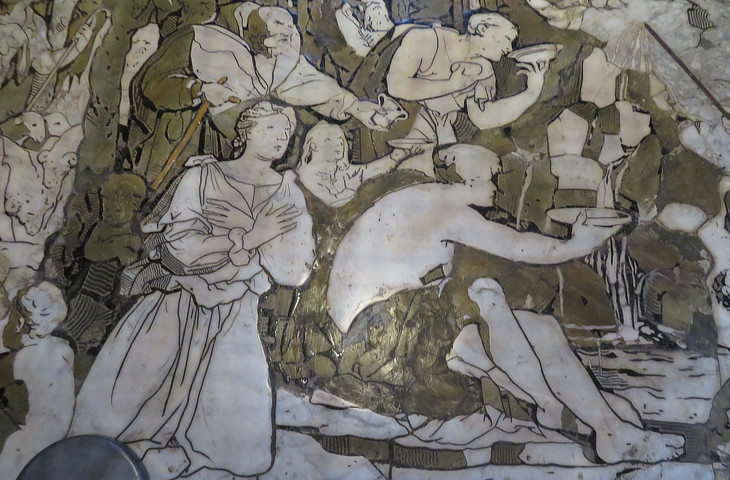
Floor: Detail of Moses pouring water from the rock by Domenico Beccafumi (1525-1547) who managed to give the marble inlay the appearance of a painting
The pavement is unique and unrivalled as a work of art in its own peculiar class, but it wants distance to give it effect, and would probably be better appreciated if it could be seen from above. It has not the tessellation of mosaic, but it consists of a dark grey marble inlaid upon white, with lines of shading resembling niello. The oldest of these works are the Samson, Judas Maccabeeus, Moses, the five kings of the Amorites taken in the cave of Makkedah (Joshua x. 16), and the Deliverance of Bethuliah, by Duccio di Buoninsegna: Absalom hanging by his Hair is also attributed to this master. The grandest compositions are those by Beccafumi, particularly the Sacrifice of Isaac, the Adam and Eve after the Fall, and the Moses on Mount Sinai, said to have been his latest work. (..) The most recent are those executed at the close of the sixteenth century: among which are the Ten Sibyls. The Erythreean, the Seven Ages of Man, the figures of Religion, Faith, Hope, and Charity, are by Antonio Federighi, who also designed the Battle of Jephthah, executed by Bastiano di Francesco. The pavement of the choir was covered with boards about two centuries ago, in consequence of the injury it received from the constant tread of visitors. On great festivals the planks are removed, but at other times there is no difficulty in obtaining permission to raise them in order to examine the pavement. Murray
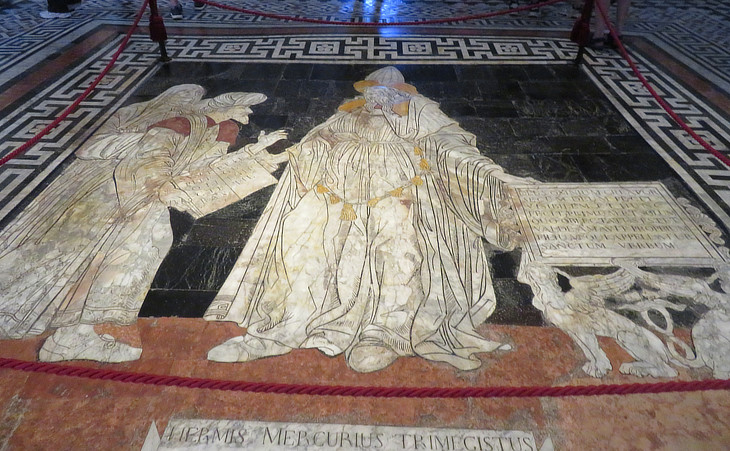
Floor: Hermes Trismegistus (Hermes the Thrice-Greatest, a legendary figure) offering the Pimander to a Gentile and a Christian by Giovanni di Stefano (1488)
The symbols of Siena and her allied cities - the Hermes Trismegistus offering the Pimander to a Gentile and a Christian, Socrates and Crates climbing the Mountain of Virtue, the Wheel of Fortune, with the Four Philosophers in the angles, are among the most curious of these works. Murray
This large mosaic is placed at the beginning of the main nave and its subject testifies to the impact that the Fall of Constantinople in 1453 had on Italian culture. Cardinal Basilius Bessarion and other savants fled to Rome carrying with them books which were unknown in Italy. Among them The Divine Pimander of which the following excerpt explains the name (1650 translation by John Everard): My thoughts being once seriously busied about things that are, and my Understanding lifted up, all my bodily Senses being exceedingly holden back, as it is with them that are heavy of sleep, by reason either of fulness of meat, or of bodily labour: Methought I saw one of an exceeding great stature, and of an infinite greatness, call me by my name, and say unto me, What wouldst thou hear and see? Or what wouldst thou understand to learn and know?
Then said I, Who are Thou? I am, quoth he, Poemander, the mind of the great Lord, the most mighty and absolute Emperor: I know what thou wouldst have, and I am always present with thee.
In 1463 Marsilio Ficino, one of the most influential humanist philosophers of that time, translated a collection of Hellenistic Greek documents which included the Pimander into Latin (Corpus Hermeticum). Cardinal Francesco Piccolomini Todeschini, the future Pope Pius III, was also Archbishop of Siena and he considered Hermes Trismesgistus as a symbol of Wisdom, worth of being portrayed in the Cathedral.
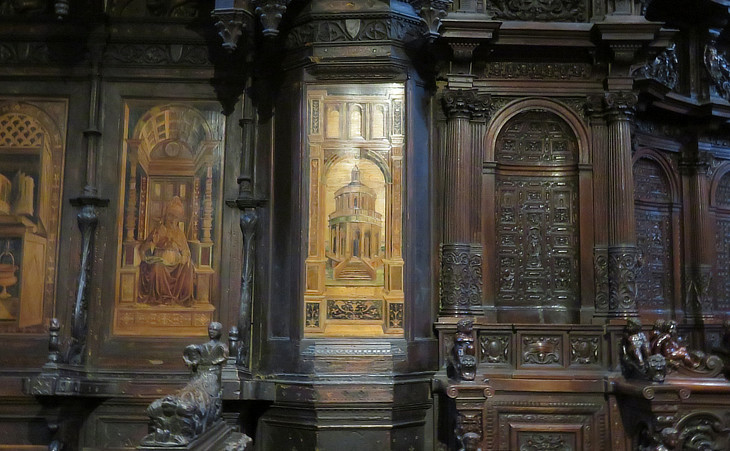
Apse stalls: (left) late XIVth century and similar to those in the chapel of Palazzo Pubblico; (right) decorated with small pieces of glass (1503)
The seates of the Chauncell are of Walnut-
tree, curiously carved. Moryson
In the choir the carvings of the stalls were begun in 1387 by Francesco Tonghi, and completed by Bartolini of Siena and Benedetti of Montepulciano, from the designs of Bartolommeo Neroni (Riccio). Murray
In the XIVth century Siena saw the development of a school of wood inlayers whose works were requested also by other towns.
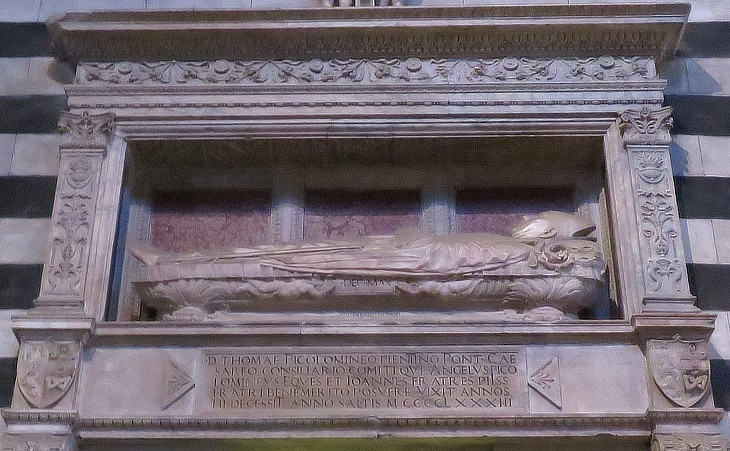
Monument to Bishop Tommaso del Testa Piccolomini by Neroccio di Bartolomeo 1484-1485 (right aisle)
Pope Pius II (Aeneas Sylvius Piccolomini) was born at Corsignano, a small hamlet east of Siena which he turned into a town bearing his name (Pienza). In this little town, which stands on the summit of one of a series of bare volcanic hills, Bernardo Rossellino built a palace, a cathedral, a canonica, and a municipal palace. The new bishopric see of Pienza was assigned to a member of the Piccolomini family from 1470 to 1599. The monument to Tommaso Piccolomini is pretty traditional in portraying the bishop in his ecclesiastical robe, but the frame is decorated in Renaissance style.
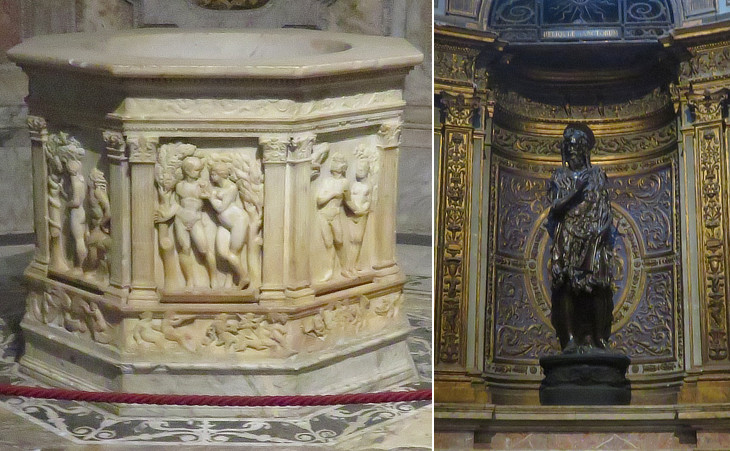
Cappella di S. Giovanni Battista: (left) baptismal font by Antonio Federighi (1484); (right) bronze statue of St. John the Baptist by Donatello (1457) - see another work by Donatello for the Cathedral
And in a Chappell of this
Church, is a most faire Font. Moryson
They showed us an arm of St. John the Baptist wherewith, they say, he baptized our Saviour in Jordan; it was given by the King of Peloponnesus (the Despot of Mistra) to one of the Popes, as an inscription testifies. They have also St. Peter's sword, with which he smote off the ear of Malchus. Evelyn
The Chapel of St. John the Baptist, a circular building, was designed by Baldassare Peruzzi; it contains some bas-reliefs of the history of Adam and Eve, by Jacopo della Quercia, and the statue of St. John by Donatello, besides several ornamental works by Sienese sculptors of less eminence. In this chapel is said to be preserved the relic of the Baptist's arm, presented by Thomas Paleologus to Pius II. Murray
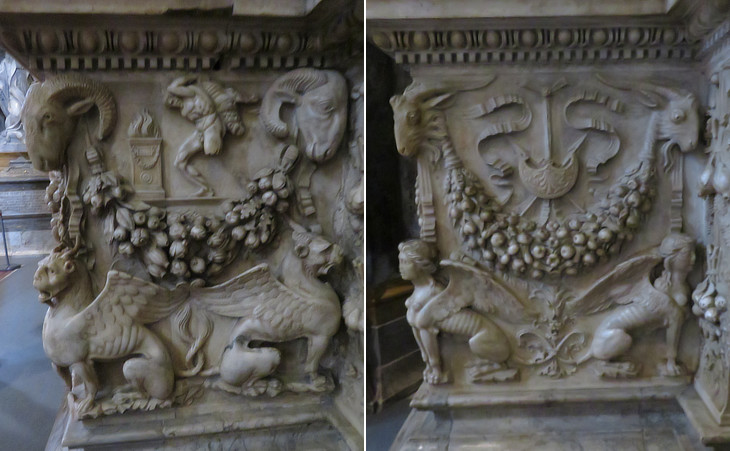
Cappella di S. Giovanni Battista: pedestals of the columns at the entrance to the chapel: (left) by Antonio Federighi (d. 1483); (right) by Giovanni di Stefano (1444-1511)
The external decoration of the chapel was designed by sculptors from Siena and it is characterized by pedestals of columns which greatly resemble ancient Roman altars. The first to be made is a work by Antonio Federighi who visited Rome in 1458 and acquired an in-depth knowledge of ancient sculpture which is noticeable also in his decoration of Cappella di Piazza.
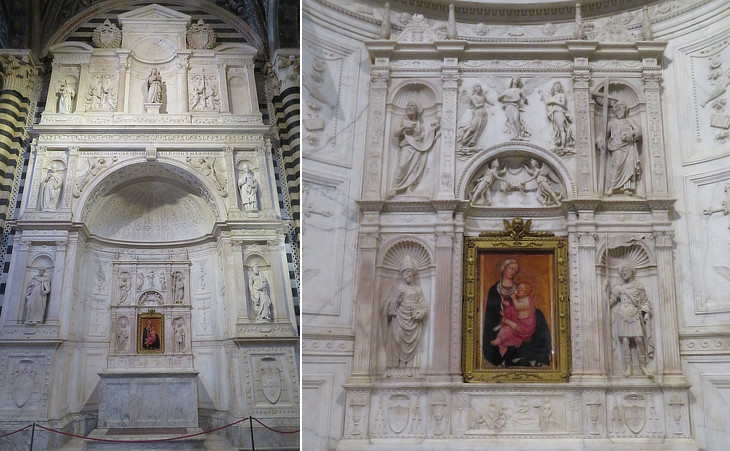
Piccolomini Altar by Andrea Bregno (1481-1485): (left) overall view; (right) central niche
Cardinal Piccolomini Todeschini commissioned Andrea Bregno with the execution of a large altar, similar to that which the sculptor had made in S. Maria del Popolo for Pope Sixtus IV (it was eventually dismantled). At the time Bregno was the leading sculptor in Rome and he had a very active workshop.

Piccolomini Altar: statues of St. James and St. Peter which are attributed to Michelangelo
Bregno did not manage to complete the statues of the altar. In 1501 Cardinal Piccolomini commissioned Michelangelo with the missing statues. The artist however was very busy with other more challenging works and only in 1504 four statues by his workshop enriched the altar. They do not add much to the fame of the artist.
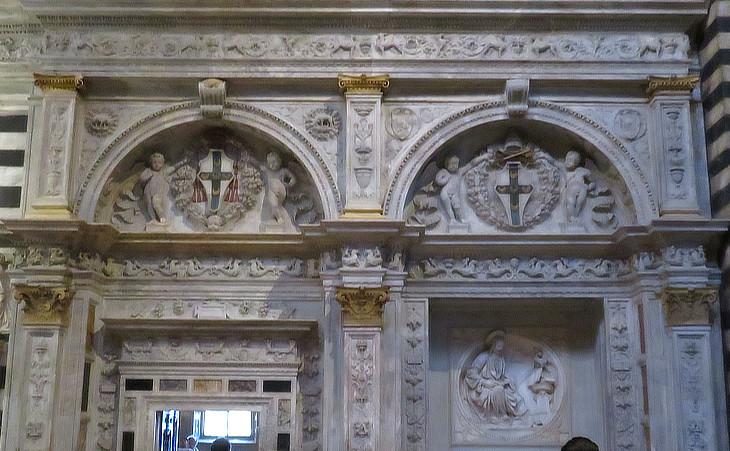
Entrance to the Piccolomini Library which was designed by Lorenzo di Mariano Fucci aka il Marrina in 1497 for Cardinal Piccolomini Todeschini
On the left side of the altar is the library, where are painted the acts of Aeneas Sylvius, and others by Raphael. Evelyn
In one chappel in that Church is upon
the wall 10 Pictures concerning the story of Aeneus
Silvius painted in such a lively manner that it almost
seems naturall. Mortoft
The painting of the Library walls in this Church, containing the History of Aeneas Sylvius afterwards Pope Pius II, half by the hand of Petrus Peruginus, and half by Raphael Urbin, is in my judgment the most excellent painting that ever I beheld, and so fresh and lively as if it had been done but yesterday. Ray
After a debate which lasted for centuries today art historians assign the execution of the frescoes entirely to il Pinturicchio, who had achieved fame with his frescoes in Roman chapels e.g. at S. Maria in Aracoeli.
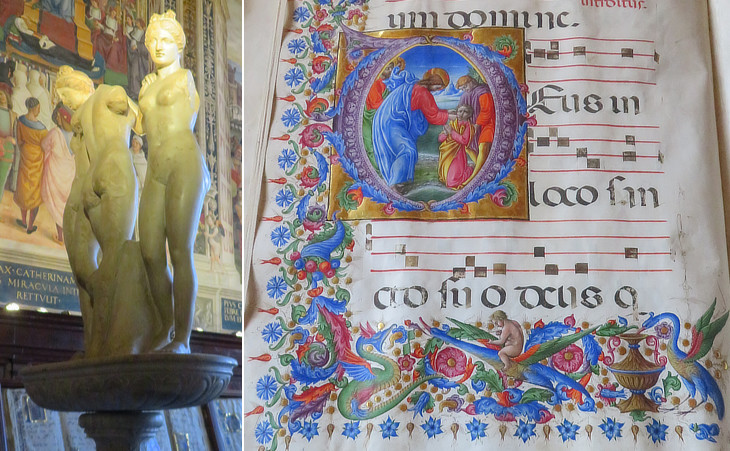
Piccolomini Library. (left) The Three Graces, an ancient Roman statue (see this subject in a statue at Perge and in a mosaic at Philippopolis); (right) choir-book containing antiphons
On the left hand (within the Church) stands the Library, painted with a rare Fresco, which is yet ravishing and lively after two hundred years: Indeed, the brave actions of Aeneas Sylvius, (afterwards Pope Pius II) which these Pictures represent, deserve to be painted by the Sun-beams. (..) But, when all is done, give me Books in a Library, not Pictures. Lassels
Fronting this chapel is a library without books; for scored music and illuminated psalms hardly deserve that title. It contains a series of gaudy, gilt pictures which, though painted by Pinturrichio, bear the name of Raphael, from some accidental touches lent by the immortalizing master. Whatever Raphael sketched, or began to sketch, walls which he never painted, jars which he never saw, statues which he never cut, are still called Raphael's. Forsyth
In the library is also preserved the exquisite antique group of the Graces in Greek marble. This group, one of the finest known examples of Grecian sculpture, was copied by Canova, and was so much admired by Raphael that he made a sketch of it, which is still preserved in the Academy of Venice. (..) The choir books, which give the name of library to this apartment, contain some beautiful miniatures by Fra Benedetto da Matera, a Benedictine of Monte Casino, and Fra Gabriele Mattei of Siena; one of the missals is illuminated by Liberale of Verona. The collection was formerly much larger, but many of them were carried to Spain by Cardinal Burgos. Murray
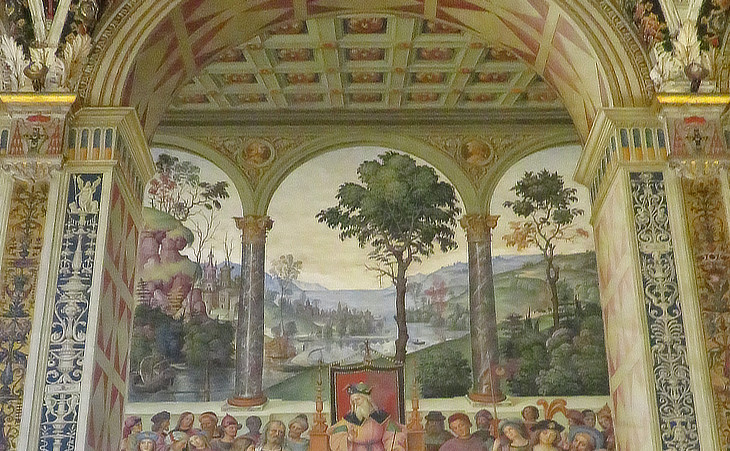
Piccolomini Library: Scottish landscape in a fresco depicting a visit by Aeneas Sylvius to James I of Scotland
The Library is decorated with ten frescoes, illustrating different events in the life of Pius II. (Aeneas Sylvius); outside is an eleventh, representing the coronation of his nephew Pius III. These works, which are particularly remarkable for the preservation of their colours, were painted, as a commission from the latter pontiff, when Cardinal Piccolomini, by Pinturicchio. Murray
In 1435 Aeneas Sylvius was sent by Cardinal Niccol˛ Albergati, Eugenius IV's legate at the council of Basel, on a secret mission to Scotland, the object of which is variously related even by himself. He visited England as well as Scotland, underwent many perils and vicissitudes in both countries and left an account of each. The journey to Scotland proved so tempestuous that Piccolomini swore that he would walk barefoot to the nearest shrine of Our Lady from their landing port. This proved to be Dunbar; the nearest shrine was 10 miles distant at Whitekirk. The journey through the ice and snow left Aeneas afflicted with pain in his legs for the rest of his life. Only when he arrived at Newcastle did he feel that he had returned to "a civilised part of the world and the inhabitable face of the Earth", Scotland and the far north of England being "wild, bare and never visited by the sun in winter".
Pinturicchio excelled in the depiction of Italian landscape; in this fresco he added some rugged rocks and a town with towers and spires in the attempt to suggest he had depicted a Scottish landscape. Other images of the library can be seen in a page dedicated to Pope Pius III.
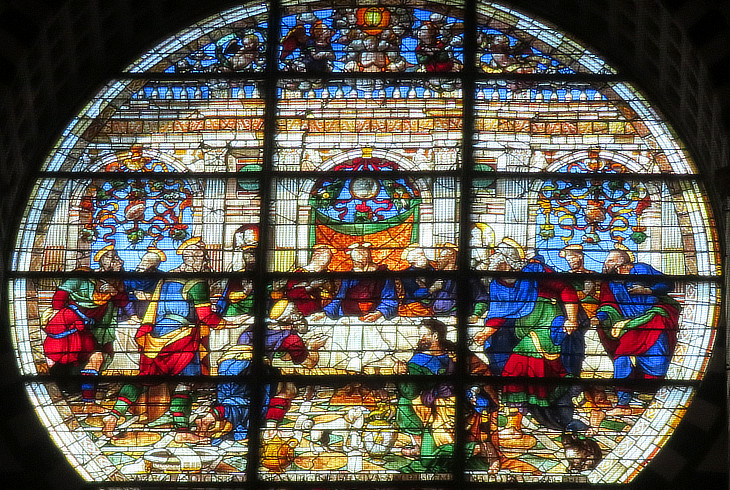
Stained glass window of the fašade depicting The Last Supper; the stained glass window by Duccio di Boninsegna in the apse has been relocated to Museo dell'Opera del Duomo
After the designs of Perino, likewise, the glass windows were executed by Pastorino da Siena, an able master of that craft.
Giorgio Vasari - Lives of the most eminent painters, sculptors & architects - transl. by Gaston Du C. De Vere
The beautiful painted glass of the wheel-window was designed by Perino del Vaga, and executed by Pastorino di Giovanni Micheli of Siena, in 1549. Murray
Vasari made reference to the decoration of the Papal Palace in Rome and to a Pastorino who was an able medallist. A record in the accounting books of the Opera del Duomo mentions a payment to a Pastorino di Giovanni Micheli for having restored the glass inlays of the Cathedral of Siena. The Last Supper depicted in the glass window is very similar to that designed by Leonardo da Vinci in 1498 (it opens in another window).
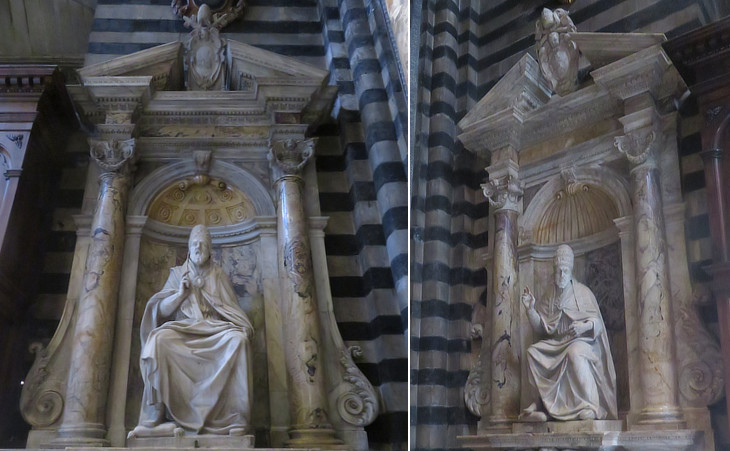
Statues of Popes: (left) Marcellus II; (right) Paul V
In this Church are two
sepulchers, one of Pope Alexander the third, the other
of Pope Pius the second. Moryson
In the Church you see the Statues of Alexander the III, of Pius II, of Paulus V and of Alexander the VII all Popes, and Natives of Siena. Lassels
A statue of Pope Pius III was added in the XVIIIth century. Pope Marcellus II belonged to a noble family of Montepulciano, a town near Siena which however made an alliance with Florence. Pope Paul V (Camillo Borghese) was born in Rome, but he descended from a noble family of Siena, where a palace is still named after them. A hall of Palazzo Pubblico is decorated with frescoes depicting the deeds of Alexander III.

Mannerist paintings: (left) Crib (1598) by Alessandro Casolani in the transept; (right) The Jews in the Desert (1611) by Ventura Salimbeni in the apse (see another painting by Salimbeni in Perugia)
The first half of the XVIth century saw a long confrontation between Spain and France for the hegemony in Italy. At his time the Italian States were confronted with the war between France and Spain for the hegemony in Italy. In 1552 the Republic of Siena with the support of French troops rebelled against a Spanish garrison. In the following years the troops of Emperor Charles V defeated those of Siena and laid siege to the town which fell in 1559. The Republic of Siena was assigned as a duchy to Cosimo de' Medici and eventually became part of the Grand Duchy of Tuscany.
These political developments led to a decline of the activities for the embellishment of the Cathedral.
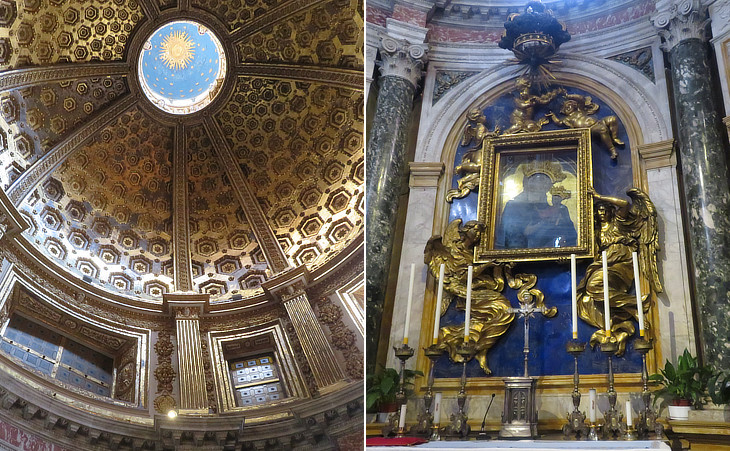
Cappella Chigi or della Madonna del Voto (right-transept): (left) dome; (right) altar (similar to that at Cappella Paolina in Rome)
The Capella Chigi in this Church, made by Pope Alexander VII. is exceeding beautiful, and in true Taste of Architecture. There are in it two fine Statues of Bernini; Mary Magdalene, and S. Jerom. Wright
Alexander VII was a patron of the arts and he commisioned Gian Lorenzo Bernini, the leading architect and sculptor of his time the design of a new chapel on the site of the Porta del Perdono. For the use of precious marbles and of a complex decoration it rivals with Cappella Cornaro, an earlier work by Bernini.
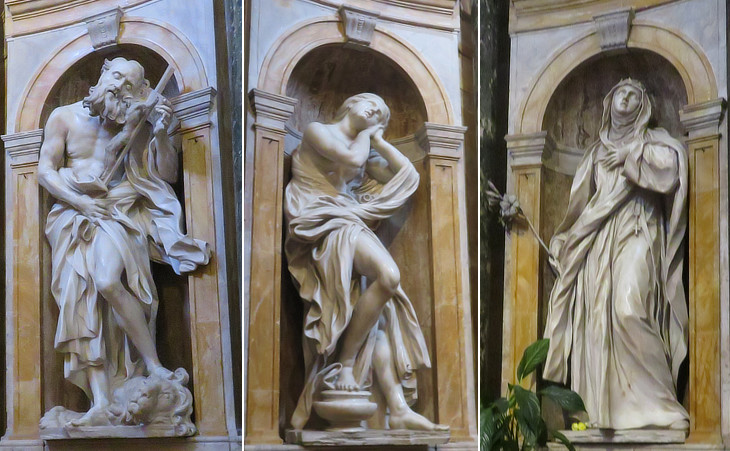
Cappella Chigi: statues of St. Jerome, St. Mary Magdalene and St. Catherine of Siena
The chapel of the Madonna is remarkable for its fine statues; those of S. Jerom and S. Mary Magdalen are the work of cavalier Bernini; and the other two by one of his scholars. Nugent
The Chigi chapel glares with rich marble, silver, gilt, bronze, and lapislazzoli. There the sweeping beard and cadaverous flanks of St. Jerome are set in contrast with the soft beauty of a Magdalene, which Bernini had transformed from an Andromeda, and thus left us the affliction of innocence for that of guilt. Forsyth
It has already become apparent that not much need be said about the development of sculpture outside Rome. With Rome's supremacy incontestably established, Roman sculptors catered for the need of patrons all over Italy. As a rule figures and busts were sent from Rome. Bernini provided work for Spoleto, Siena, Modena, Venice, and Savona. (..) Not Florentines or Sienese but CaffÓ, Ferrata, and Raggi gave Siena Cathedral monumental Seicento sculpture. Later, Giuseppe Mazzuoli, born near Siena, inundated Siena with Berninesque statuary.
Rudolph Wittkower - Art and Architecture in Italy 1600-1750
See a directory of Roman Baroque Sculpture.
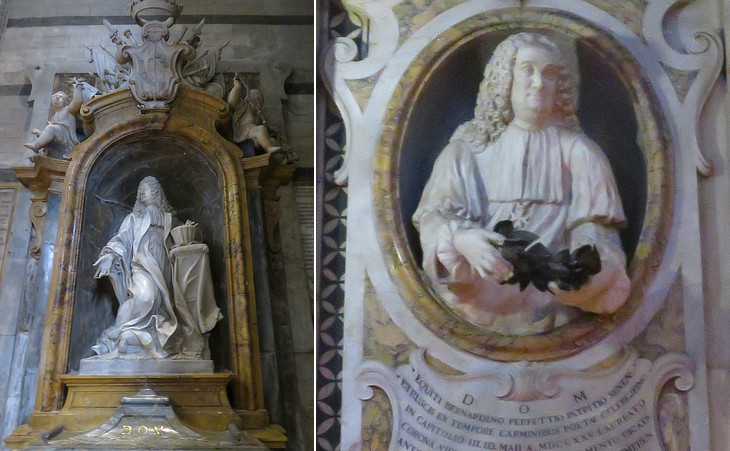
Cathedral - Monuments by Giuseppe Mazzuoli: (left) Marc'Antonio Zondadari, Grand Master of Malta; (right) Bernardino Perfetti (1681-1746) a member of the Accademia degli Intronati and a poet who was crowned in Campidoglio
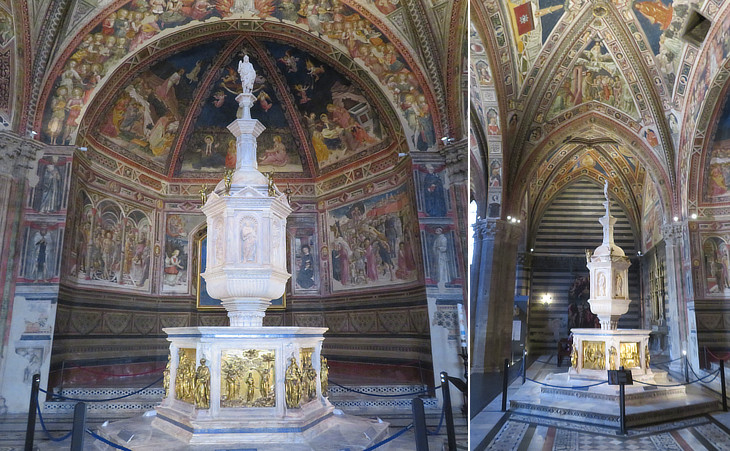
Baptistery (S. Giovanni): (left) front view; (right) side view
Among its beautiful ornaments are the Baptism of the Saviour, and the St. John before Herod, by Lorenzo Ghiberti; the Banquet of Herod, by Pietro Pollayolo, an able Florentine sculptor and goldsmith of the 15th century; the St. Joachim by Donatello; the Birth of St. John, and his Preaching in the Desert by Jacopo della Quercia. Murray
It contains the famous font with sculptures by Jacopo
della Quercia, Donatello, Ghiberti, and Turini, with its
picturesque centre piece, a favourite subject for artists. Graham Jackson
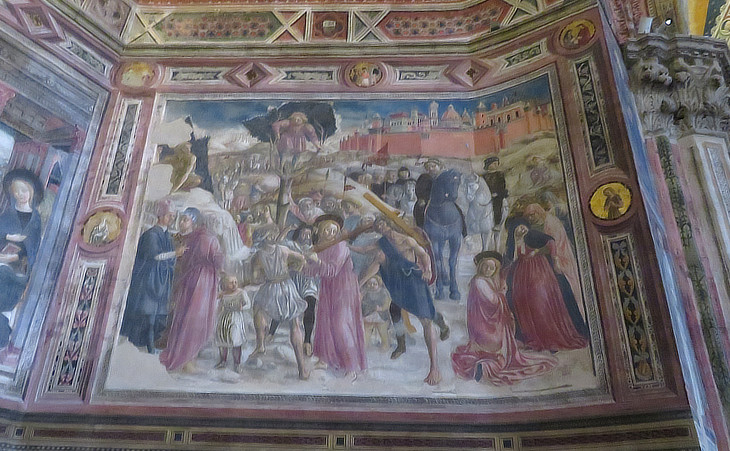
Baptistery: A scene from the Life of Jesus (1453) by il Vecchietta
A Sienese and also a much extolled sculptor was Lorenzo, the son of Piero Vecchietti, who, having first been a highly esteemed goldsmith, finally devoted himself to sculpture and to casting in bronze; which arts he studied so zealously that he became excellent in them. (..) Over the door of S. Giovanni he painted an arch with figures wrought in fresco; and in like manner, since the baptismal font was not finished, he wrought for it certain little figures in bronze, besides finishing, also in bronze, a scene formerly begun by Donatello. (..) He was a melancholic and solitary person, ever lost in contemplation; which was perchance the reason that he did not live longer, for he passed to the other life at the age of fifty-eight. Vasari
Lorenzo di Pietro di Giovanni di Lando, commonly known as
Il Vecchietta deserves a more extended notice, being one of the most original artists of the Sienese school. This gifted man, who distinguished himself as goldsmith, architect, sculptor, and painter, was born at Castiglione di Valdorcio, in the Sienese territory, in 1412. (..) He is well known as a painter to all lovers of the Sienese school by his pictures at Siena and Florence. Perkins
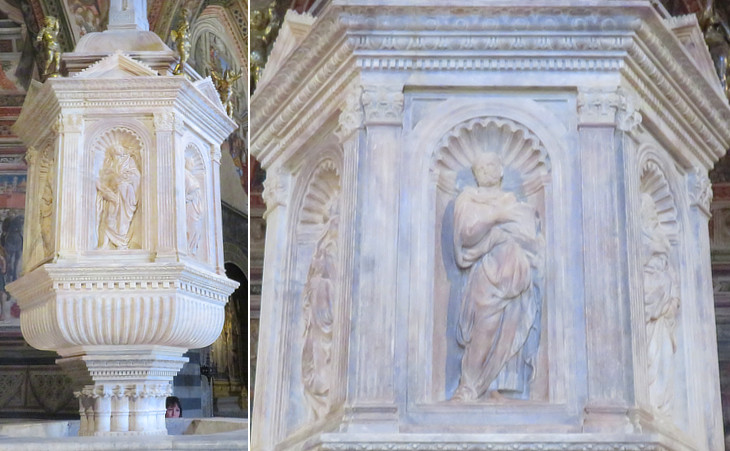
Baptistery: Baptismal font and a detail of a statue of a Prophet by Giovanni di Turino (1424)
Maso Finiguerra taught his art to the Florentine Mazzingo and to Giuliano del Facchino, both passing good masters, and to Giovanni Turini of Siena, who surpassed these his companions considerably in that profession, in which, from Antonio di Salvi to our own day, there has been nothing done than can be held in particular account. But of his works and of those of the Pollaiuoli many have been destroyed and melted down to meet the necessities of the city in times of war. Vasari
Among the contemporaries of Quercia at Siena, were the goldsmith Turino di Sano, and his son Giovanni, goldsmith, sculptor, and niellist. Perkins
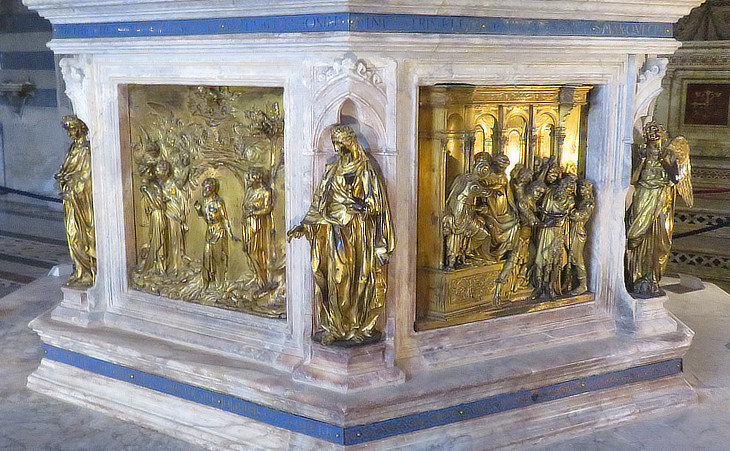
Baptistery: lower part of the baptismal font with two bronze reliefs by Lorenzo Ghiberti (Baptism of Jesus and Capture of St. John Baptist) and a statue by Donatello (Faith)
The fame of Lorenzo, by reason of his most profound mastery in casting, had now spread throughout all Italy and abroad, insomuch that Jacopo della Fonte, Vecchietto of Siena, and Donato having made for the Signoria of Siena some scenes and figures in bronze that were to adorn the baptismal font of their Church of S. Giovanni, the people of Siena, having seen the works of Lorenzo in Florence, came to an agreement with him and caused him to make two scenes from the life of S. John the Baptist. In one he made S. John baptizing Christ, accompanying it with an abundance of figures, both nude and very richly draped; and in the other he made S. John being taken and led before Herod. In these scenes he surpassed and excelled the men who had made the others; wherefore he was consummately praised by the people of Siena, and by all others who have seen them. Vasari
Move to From Porta Camollia to S. Domenico
Piazza del Campo
Cathedral - Exterior
Opera del Duomo (to be developed)
S. Maria della Scala (to be developed)

